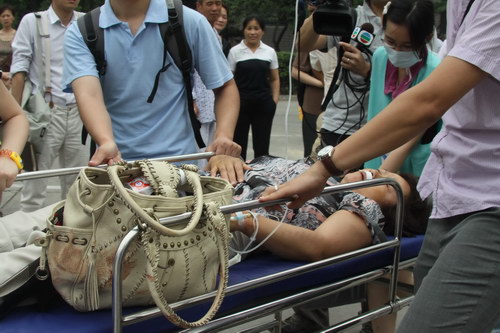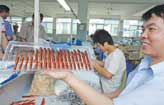Economy
Escalator safety in spotlight
Updated: 2011-07-14 09:57
By Jiang Xueqing (China Daily)
China's standards
China has adopted safety rules for the construction and installation of elevators, escalators and the horizontal conveyors often seen in airports. Chinese technical standards are equal to European standards (EN81-1:1998 for elevators and EN115:1995 for escalators), but the passenger flow at Chinese subway and railway stations is much greater than that in Europe.
Every day, more than 7 million journeys are made on 14 Beijing subway lines, which run a total of 336 kilometers, Li Xiaosong, spokesman of the Beijing Municipal Commission of Transport, said at a news conference.
|
The escalator at the Beijing South Railway Station is one of the busiest in the city. The government has tightened supervision of escalator inspections, and those for elevators, in locations ranging from public transport stations to residential buildings. [Photo/China Daily] |
Besides traffic flow, local area characteristics and environment are important considerations in setting safety standards for elevators and escalators, said an expert at the Guangdong Elevator Technology Institute who asked to remain anonymous. For example, compared with European cities, Beijing needs sturdier elevators and escalators because it is windier, dustier and more polluted here.
"The safety standards for elevators and escalators in China should be set higher than the European standards, so that the standards will conform more smoothly to the Chinese conditions," the expert said.
The standards are only a threshold for market access, Zhang said, but an escalator of good quality far exceeds the basic standards.
"If a truck with a loading capacity of 20 tons and above is called a heavy-duty truck, do I need to buy a truck that can carry a maximum weight of 50 tons or 100 tons?" he said. "It's a complicated calculation based on many factors."
Experts said that because safety standards do not meet the actual demands of public transportation in China, it is hard to simply blame either manufacturers or operators.
The government is tightening its supervision of inspections of escalators and elevators. Zhao Hui, who lives in an Air Force residential compound in Beijing, noticed that the safety test certificate posted in an elevator of her building had expired. The next day, she ran into a person changing the certificate, who explained the elevator had been repaired in February but the bill hadn't been paid. Now with the government checking elevators, the managers had to replace the certificate in a hurry.
Elevators should be cleaned, lubricated and inspected at least once every 15 days, according to safety regulations for special equipment. In addition to the 478 registered elevator manufacturers, about 4,500 service companies have obtained permits to install and maintain elevators.
Booming industry
Thanks to the fast development of the real estate market and public transportation systems in recent years, China has become the largest manufacturer of elevators in the world, with the most existing installations and newest installations, according to statistics from the China Elevator Association.
By the end of 2010, China had nearly 14 percent of all the world's elevators and more than 44 percent of its escalators. Brands owned by Otis accounted for the largest proportion (20 percent) of new installations.
China produced 45,000 escalators and horizontal conveyors last year, accounting for 90 percent of new installations worldwide, and 320,000 elevators, 64 percent of the world total. About 37,200 of the elevators, escalators and conveyors produced were exported.
Statistics on elevator and escalator accidents, especially in recent years, are extremely hard to find, despite central government requirements that different levels of safety supervision bureaus inform the public regularly about accidents.
According to an old report posted on the China Elevator Association website, China had 53 serious elevator and escalator accidents in 2003, including 24 in passenger elevators and four on escalators. The accidents caused 39 deaths, 18 injuries and direct financial losses of 1.34 million yuan ($207,260). While the number of accidents fell the next year to 22, with 18 deaths and nine injuries, the financial losses rose to 2.06 million yuan.
'It takes joint efforts'
Zhai Qi, a 28-year-old writer who lives in the Guangquan residential complex in Beijing's Chaoyang district, was caught in an elevator about two months ago. It happened during morning rush hour.
The Xizi Otis elevator, with seven or eight people on board, suddenly shook roughly and stopped halfway down the 22 stories. The door remained shut. Some passengers pushed the emergency button to alert the elevator supervisor, but no one answered. Others called the property management company and were told to wait for help.
Before anyone arrived, the elevator resumed operation and released the worried passengers safely to the ground. It lasted only about four minutes, Zhai said, but felt much longer.
Another elevator in his building broke down every one or two weeks, Zhai said. It once took a month to have it repaired. The property managers posted a notice accusing some residents of breaking the elevator on purpose and warning that the police would be called if it were damaged again.
"The maintenance of elevators does not simply rely on manufacturers or service companies," said Li of the elevator quality center. "It takes joint efforts of all related parties to ensure elevator safety."
 |
|
A victim of the escalator accident at a Line 4 subway station is on her way to People's Hospital nearby in Beijing. The accident on July 5 killed a 13-year-old boy and injured 30 passengers. [Photo/China Daily] |

Specials

90th anniversary of the CPC
The Party has been leading the country and people to prosperity.

The write stuff
'Pen capital' goes back to drawing board for answers to economic changes taking shape in Zhejiang

Say hello to hi panda
An unusual panda is the rising star in Europe's fashion circles